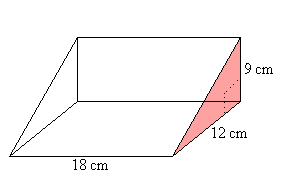

The volume of a hexagonal prism formula = 3 x apothem length x base length x height The volume of a pentagonal prism formula = 5/2 x apothem length x base length x height The volume of a triangular formula= ½ x apothem length x base length x height The volume of a rectangular prism formula = Base width x base length x height The surface area of a hexagonal prismformula = 6 x (apothem length x base length) + 6 x (base length x height) The surface area of a pentagonal prism formula = 5 x(apothem length x base length) +5 x (base length x height) The surface area of a triangular prism formula = (Apothem length x base length) + 3 x (base length x height) The surface area of a rectangular prism formula = 2 x (base length x base width) + (base width x height) + (height x base length) The base area of a hexagonal prism formula = 3 x apothem length x base length. The base area of a pentagonal prism formula = 5/2 x apothem length x base length. The base area of a triangular prism formula = ½ x apothem length x base length. The base area of a rectangular prism formula = base length x base width. There can be yet two other types of prisms that can also be a right prism and oblique prism. These were the few different types of prisms. Hexagonal Prism: In a Hexagonal Prism, there are 2 hexagonal surfaces parallel to each other and 6 rectangular surfaces that are inclined to each other. Pentagonal Prism: In a Pentagonal Prism, 2 pentagonal surfaces are parallel to each other and 5 rectangular surfaces that are inclined to each other. Triangular Prism: In a Triangular Prism, there are 2 parallel triangular surfaces, 2 rectangular surfaces that are inclined to each other and 1 rectangular base. Rectangular Prism: In a Rectangular Prism, 2 rectangular bases are parallel to each other and 4 rectangular faces. The height of the prism is basically the common edge of two adjacent side faces. The base and the top has one edge common with every lateral face.

In a prism, except the base and the top, each face is a parallelogram. Now that we know what is a prism, we can know the properties of prism easily.Īmong all the properties of the prism the most basic is that the base and top of the prism are parallel and congruent. The surface area of a prism = (2×BaseArea) +Lateral Surface Area In physics (optics), a prism is defined as the transparent optical element that has flat and polished surfaces used for refracting light.


In mathematics, a prism is defined as a polyhedron. The third rectangular surface at the bottom is the base of the prism.Īgain, the question of what is a prism can be answered in two ways as the concept of it is used in both mathematics as well as science. The section of the prism that is perpendicular to the refracting edge is called the principal section of the prism. The angle formed between these two refracting surfaces is called the refracting edge of the prism. The two inclined rectangular surfaces through which the light passes are called the refracting surfaces. A prism is a transparent solid used for refraction. Along with the triangles, three rectangular surfaces are inclined to each other. In a prism, there are two identical parallel triangles opposite to each other. A prism is a five-sided polyhedron with a triangular cross-section.


 0 kommentar(er)
0 kommentar(er)
